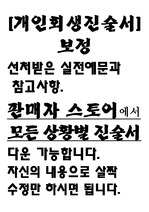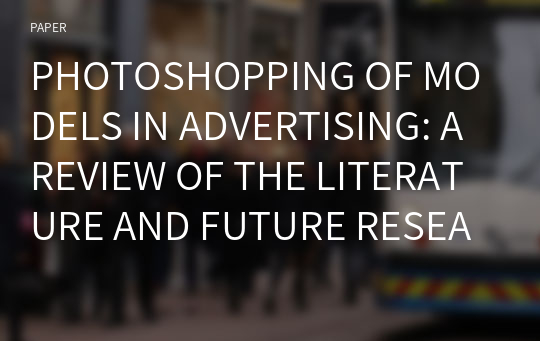PHOTOSHOPPING OF MODELS IN ADVERTISING: A REVIEW OF THE LITERATURE AND FUTURE RESEARCH AGENDA
* 본 문서는 배포용으로 복사 및 편집이 불가합니다.
서지정보
ㆍ발행기관 : 글로벌지식마케팅경영학회(GFMC)
ㆍ수록지정보 : Global Marketing Conference
ㆍ저자명 : Charles R. Taylor, Danielle Smith, Yoon-Na Cho, Carissa Anthony
ㆍ저자명 : Charles R. Taylor, Danielle Smith, Yoon-Na Cho, Carissa Anthony
영어 초록
In recent years, there has been increased attention on the portrayal of women in the media. Photoshopped images of unrealistic female forms have been perceived to have negative impacts on the self-esteem of those exposed (Groesz 2002). Based on the idea that seeing unrealistic body images can put undue pressure on women and impact their self-esteem, some governments have gone as far to propose and or pass legislation that ban or require disclosures on such images in advertising. For example, multiple attempts have been made to pass the Truth in Advertising Act in the U.S., which would severely restrict the ability to digitally alter ad (Navamanikkamm 2017). Meanwhile. France passed a law in 2017 mandating that if a model’s physical person has been digitally altered in an ad it must include a disclaimer indicating that the ad has been retouched (Lubitz 2015). Recently, Israel out of concern about eating disorders at a societal level, passed legislation requiring a disclaimer in any ad whether a model is photoshopped to look thinner. The Israeli law also mandates that a threshold body mass index be met for a model to be included in an ad. With the United Kingdom’s Advertising Standards Authority also banning some campaigns due to exaggerated retouching, it is clear that photoshopping of models in advertising is under scrutiny (Sweney 2017). Several companies have also taken a stand on photoshopping of ads. These include Aerie Lingerie, CVS Drugstores, Dove, and Britain’s ASOS, all of whom has committed to having realistic images in their ads and reducing or eliminating retouching (Horwath 2016; Zillman 2017; Bomey 2018). In spite of the increased attention being paid to photoshopping of ads by regulators, companies, and some in the public, research on the topic has been relatively sparse. This paper aims to summarize what is known about the societal and managerial implications of digital retouching and offers future research directions designed to make advances in these areas. To this end, this paper begins by reviewing work in three areas related to photoshopping of ads. The first topic addressed is whether edited images of unrealistic standards have a negative impact on the viewer. Secondly, we examine what is known about the implications of including disclosures and disclaimers on the consumers psyche, (i.e. do these warnings negate the implied negative consequence of the edited images). Finally, the impact such disclosure labels have on ad effectiveness and purchase intention is considered. To ensure the full scope of pertinent material was covered, articles were targeted via databases such as ABI/ Inform, Business Source Premier, EBSCO and Google Scholar. Because of the paucity of articles, no time limitations were placed on the search. A variety of combinations of relevant search terms were used (e.g., retouching, advertising, body image, women, photoshop etc.). As key articles were identified, the sources they cited were also reviewed in relation to the purpose stated above. Our review of the literature finds a virtually universal consensus finds that idealized imagery, often characterized by very thin or “ideal” models is directly correlated to an increased risk of body dissatisfaction (Groesz 2002). Several of these studies draw on social comparison theory (Gulas 2000; Myers 2009) is commonly used as a theoretical explanation underlying this effect, with experimental studies being used to provide empirical evidence. Prior studies have tested several types of disclaimers. These studies have generally found that disclaimer do not mitigate the negative impact that the exposure to idealized image has on the consumer (Cragg 2017) Based on this research, apparently, women feel social pressure to live up to idealized images even if a disclaimer is included in the ad. However, it should be noted that only a limited number of studies have tested this effect, and additional types of disclaimers from different sources need to be tested before drawing firm conclusions. As for advertisement effectiveness, specifically product attitude and purchases intent, studies have found that advertisements using “normally attractive models” in comparison to “highly attractive models” tend to produce better results (Tsai and Chang 2007). Notably, the presence of a disclaimer does not appear to either increase or decrease the effectiveness of ad based on the extant research (Semaan, Gould and Kocher 2012; Schirmer et al., 2018). The literature does raise some questions about the needed prominence of a disclaimer to have an impact, suggesting that often times “fine print messages” are largely unnoticed in relation to a more prominent alternative (Black & Watson 2013). Notably, there is some evidence that including a “retouch-free” versus a “retouched” disclaimer does increase attitudes toward the brand and purchase intention (Cornelis and Peter 2017). The literature reviewed has limitations such as uncorroborated studies, limited sample sizes, and narrowly focused demographics in some studies. While it has generally been established that highly attractive model usage and idealized retouched imagery has a negative effect on consumer body image, there is insufficient research on the implications of disclaimers and disclosers. It is suggested that additional research is needed on the effects of various disclaimer types directly related to various levels of image re-touching (as opposed to product warnings) on consumer buying behavior and ad effectiveness (see Schirmer et al., 2018). There is some evidence that consumers are accepting of minor photoshopping of ads, such as changing the background or “fixing” a blemish, but that more major retouching such as making a model appear to have different facial features, thinner legs, or larger breasts is viewed as problematic. As such, future experimental research should focus on different levels of retouching. There is also a clear need to test different wording of disclaimers as well as disclaimers from different sources (e.g. government vs. non-profit, vs. company itself). Future research should focus on a wide cross-section of women. It should also test multiple product categories, including those beauty related vs. not beauty related.참고 자료
없음"Global Marketing Conference"의 다른 논문
 THE ROLES OF GREEN PACKAGING IN UGLY FOOD PURCHASE INTE..22페이지
THE ROLES OF GREEN PACKAGING IN UGLY FOOD PURCHASE INTE..22페이지 THE IMPACT OF INDUCED AWE ON ETHICAL TOURIST BEHAVIORS5페이지
THE IMPACT OF INDUCED AWE ON ETHICAL TOURIST BEHAVIORS5페이지 A BIBLIOMETRIC ANALYSIS OF SPIRITUAL TOURISM RESEARCH15페이지
A BIBLIOMETRIC ANALYSIS OF SPIRITUAL TOURISM RESEARCH15페이지 SOCIAL NETWORK ANALYSIS AND RESPONSE TIME TESTING: CONS..11페이지
SOCIAL NETWORK ANALYSIS AND RESPONSE TIME TESTING: CONS..11페이지 THE EFFECTS OF PARA-SOCIAL INTERACTION ON ONLINE CELEBR..3페이지
THE EFFECTS OF PARA-SOCIAL INTERACTION ON ONLINE CELEBR..3페이지 THE INFLUENCE OF OPINION LEADERS ON DAILY DEALS USER’S ..3페이지
THE INFLUENCE OF OPINION LEADERS ON DAILY DEALS USER’S ..3페이지 HOW IMMERSIVE RETAILING AFFECTS CONSUMERS’ URGE TO BUY:..6페이지
HOW IMMERSIVE RETAILING AFFECTS CONSUMERS’ URGE TO BUY:..6페이지 KEY TO SUPERSTARDOM IN A GLOBALISED MARKET: THE ROLE OF..6페이지
KEY TO SUPERSTARDOM IN A GLOBALISED MARKET: THE ROLE OF..6페이지 A POST-PANDEMIC LOOK AT TOURISTS’ PERCEIVED COOLNESS OF..4페이지
A POST-PANDEMIC LOOK AT TOURISTS’ PERCEIVED COOLNESS OF..4페이지 EXTRACTING OFFLINE RETAIL SHOPPING PATTERNS: OLLABORATI..5페이지
EXTRACTING OFFLINE RETAIL SHOPPING PATTERNS: OLLABORATI..5페이지


























